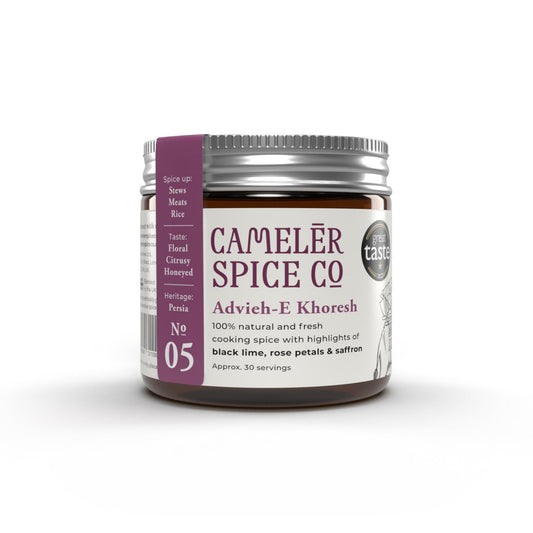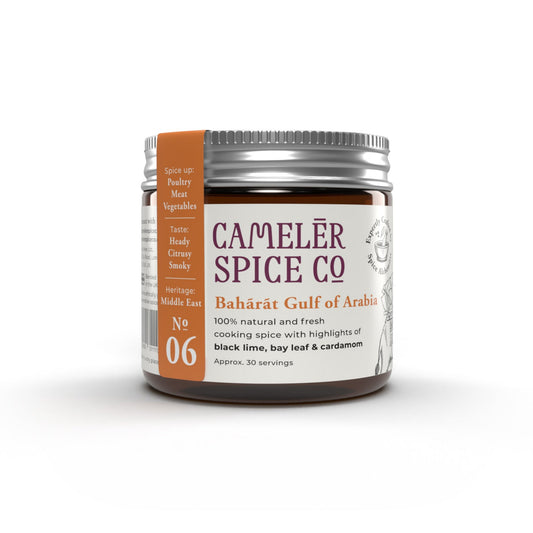
Collection: Black Lime
(Also Known as loomi, limo or dried limes)
What does black lime taste like?
Fresh limes are the sharpest taste of all citrus fruits. Black Lime (Dried limes also known as loomi) are cultivated from trees before they are ripe. Black lime has a distinctive taste profile; it is earthy, tangy, and bright, with a unique flavour that comes from the drying process. It imparts a sour, slightly sweet, and bitter taste with a strong citrus-forward aroma. We often find that it has smoky undertones when we mill them in-house. When used in cooking, black limes add depth and complexity to dishes, often contributing a sour and slightly salty taste to stews and soups.
What are black limes?
Often we get asked what makes black limes black. Black limes are blanched in salt water to sterilise and reduce bitterness, promoting brown enzymes. They are typically dried outdoors in the sun until they become hard and brittle. Black limes are limes that have been allowed longer to ferment. The drying process develops a sour and earthy quality with slightly smoky notes and a light musty base. At Cameler Spice Co most of our black lime harvest comes from the country of Oman.
What flavours go with black lime?
Black Limes (dry limes) are a great example of a sustainable fruit, traditionally harvested in Oman, but also in China, Iran, Iraq, India and the USA. As you can imagine this is rather labour-intensive making this unexpected ingredient rather expensive. This traditional fruit preservation is often used for its flavours and aromatics. Today they can be found in Western cocktail innovations. Black lime pairs well with flavors such as earthy spices, and aged spirits like rums and brandies, and can also complement tropical fruits and berries. We have an extensive list of flavours that we believe pair well with black limes (loomi)
- Anise
- Basil
- Chilli
- Cherry
- Cinnamon
- Ginger
- Grapefruit
- Pineapple
- Mango
- Mint
- Strawberry
- Thyme
Our Grandmothers' Baharat Gulf of Arabia (A Saudi all-purpose seasoning) and the 6th Century BC Persian stewing blend Advieh-E Khoresh encompass tangy and aromatic flavours where black lime partners wonderfully with cinnamon.
What are the health benefits of black limes?
Black limes are known for their health benefits, which include a high content of vitamin C and antioxidants. These nutrients can help boost the immune system, promote healthy skin, and may reduce the risk of heart disease. Additionally, black limes contain citric acid, which has been suggested to increase alkalinity in the body, protect against cell damage, decrease blood pressure, ease an upset stomach, and alleviate symptoms of acid reflux.
Fresh limes are rich in Vitamin C, and British sailors were introduced to limes after lemons in the 19th Century to protect against scurvy. A disease that is a lack of Vitamin C, typically noticeable in the gums and skin. The sailors were nicknamed "limey" after their escapades into eating Limes to protect against scurvy. Ironically it has four times less vitamin C than lemons, so they should probably have stuck with lemons in the first place.
Do black limes have the same nutritional value?
Though black limes do retain some Vitamin C and potassium, they are less nutritious than their fresh counterparts. However, it is the phenomenal smoky and citrusy flavours that we desire.
What are interesting facts about limes?
- Black limes have many alternative names, loomi or limo in Omani and dry limes in other regions.
- Limes are native to Southeast Asia. Arab traders brought dry lime to the Middle East. In the 10th Century, Arab Cameleers introduced limes to Egypt and North Africa. Then the Western European Christians brought limes into Europe during the Crusades era.
- By the 1500s, limes were introduced to the Americas, planted in the West Indies by European explorers. However, Oman is credited with putting dry limes on the cuisine map. This is likely due to the practice of using up unharvested yield that had fermented on the trees.
- Dried limes are particularly relevant to Persian cuisine and are used in many of their ‘spice mixtures’, known as Advieh.
- The Arabian Bedouins used dried lime as a black fabric dye and as a traditional digestive stimulant.
What is the chief flavour profile of limes?
Citral: (citrus and herbal) dry lime is less sharp than its fresh variety. This allows the other compounds to shine through. To add more citrusy profiles, you can add ginger or cardamom. The primary flavour profile of fresh limes is a balance of tartness and sweetness, with the Persian lime being known for its juicy, seedless interior and milder acidity, making it a versatile choice for both food and beverages. Key limes a different variety are smaller, with a stronger tart flavour and intense aroma, often used in desserts like Key lime pie. Additionally, limes can have notes of pine, lilac, spicy, and eucalyptus flavours.
Shop Spices With Black Lime
-
Advieh-E Khoresh
Regular price £8.95 GBPRegular priceUnit price / per -
Baharat Gulf Of Arabia
Regular price £8.95 GBPRegular priceUnit price / per




